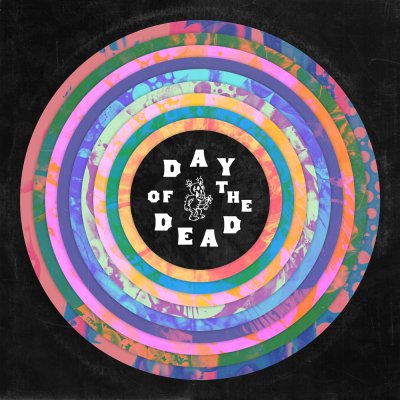For Day Of The Dead, the Dessners wanted at least some of the tracks to present a cohesive sound that befitted the Grateful Dead’s communal voice. So a “house band” formed, including the Dessners, Devendorfs, Walter Martin of The Walkmen, Takka Takka’s Conrad Doucette, and Sam Cohen and Josh Kaufman of the Yellowbirds, to arrange and record roughly half of the tracks.
During intermittent sessions in Woodstock, New York and Justin Vernon’s Eau Claire, Wisconsin studio, the band jammed with visitors such as Will Oldham, Yo La Tengo’s Ira Kaplan, and Sonic Youth’s Lee Ranaldo, recording some songs live and shipping backing tracks on others to guests such as Jim James and Lucinda Williams for the addition of lead vocals.
With a regular core, the group could get closer to capturing the tricky balance of sloppiness, spontaneity, and serendipity that the Dead perfected. The musicians went beyond studio versions to study live versions across eras, from their raw days at the Fillmore West to the slicker, slower stadium years.
“We encouraged ourselves not to tune,” Dessner laughs. “Mistakes were OK, we didn’t have to be perfect about it. I guess some of it is really tight and crisp and spot on, but it doesn’t feel overly tight, because that wasn’t their thing, either.”
The bulk of the covers originate in the band’s prolific early-’70s material: nearly the entirety of American Beauty and Workingman’s Dead appear, as well as a healthy chunk of the Europe ’72 live record. The collection is also overwhelmingly concentrated on Jerry Garcia/Robert Hunter songs, with only a handful of Bob Weir or Phil Lesh originals (Weir himself appears on two live “encore bonus” tracks, playing “St Stephen” with Wilco and “I Know You Rider” with The National). But still, over 59 tracks, nearly every dimension of the Dead finds representation.
Into the jams? Two versions of their improvisational flagship “Dark Star” appear, one comprising a three-track suite that blends live and studio performances in the style of John Oswald’s Grayfolded, the other a Krautrock reimagining by the Flaming Lips. Ranaldo’s bowed guitar leads an exploratory take on Weir’s “Playing In The Band” (sung by TV On The Radio’s Tunde Adebimpe), while Kaplan’s “Wharf Rat” takes its sweet time over a bed of glacial drones.
More into the weird stuff? Besides deconstructed versions of “Truckin’” from Minneapolis noise act Marijuana Deathsquads and “Estimated Prophet” by Terry Riley and his son, Gyan, there’s an appropriately bonkers version of the Dead’s “Drums> Space” live staple by Brooklyn’s Man Forever and Oneida. “Sugar Magnolia” and “Casey Jones” are nowhere to be found, but mega-deep cuts “What’s Become Of The Baby?” and “Rosemary” each appear in dramatically reworked form.
Songs such as Garcia’s near-forgotten “If I Have The World To Give” and the late-’80’s cut “Standing On The Moon”, are rescued from their poorly aged production with stripped down versions by Will Oldham and Phosphorescent’s Matthew Houck, respectively. Others are given a modern sheen; electro-pop versions of “Uncle John’s Band”, “Stella Blue” and “Althea” might be considered heresy by many Deadheads, but demonstrate how the band’s melodies succeed in radically different contexts.
“All of this music is sort of sacred in a way, there are times when you feel some apprehension or nervousness about doing it justice,” Dessner says. “But there’s also quite a bit of stuff more radical in interpretation, more modern and filtered through a different perspective. A lot of their songs are kind of open to interpretation, an inviting canvas to explore.”



